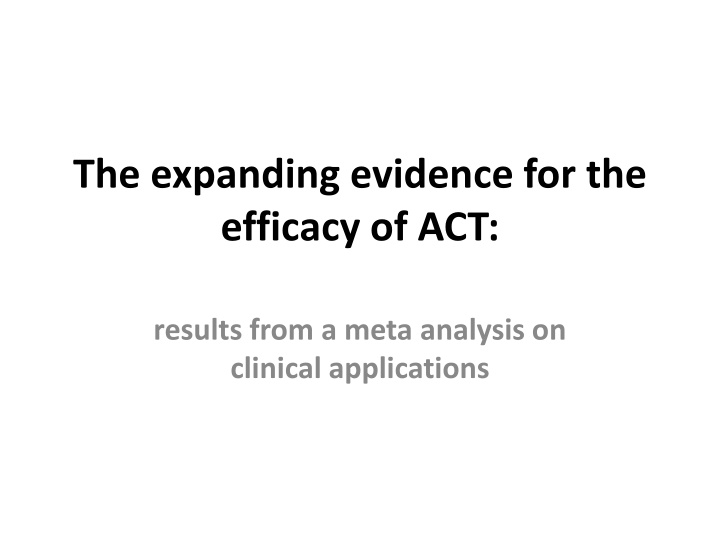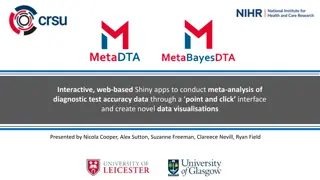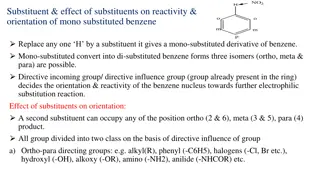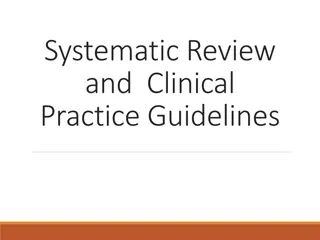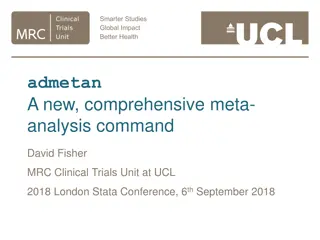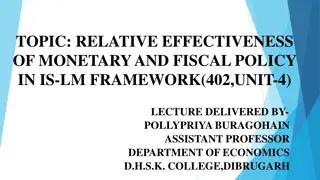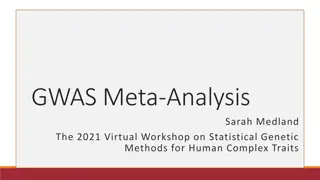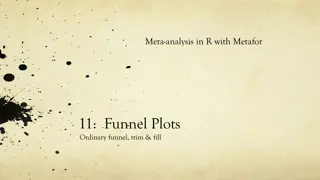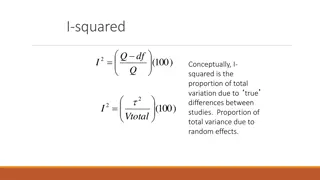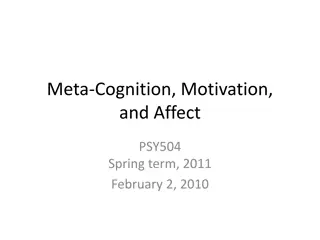Effectiveness of ACT: Meta-Analysis Results
Evidence supports the efficacy of Acceptance and Commitment Therapy (ACT) based on results from a meta-analysis on clinical applications. The meta-analysis covers various studies, including earlier analyses by Hayes et al., Ost, Powers, Veehof et al., and Ruiz. It delves into criteria for inclusion, weighting average effect sizes, comparisons with general control conditions, structured interventions, and cognitive-behavioral therapy (CBT). The findings reveal significant effect sizes for post and follow-up assessments, reflecting the effectiveness of ACT in improving psychopathology and quality of life.
Download Presentation

Please find below an Image/Link to download the presentation.
The content on the website is provided AS IS for your information and personal use only. It may not be sold, licensed, or shared on other websites without obtaining consent from the author.If you encounter any issues during the download, it is possible that the publisher has removed the file from their server.
You are allowed to download the files provided on this website for personal or commercial use, subject to the condition that they are used lawfully. All files are the property of their respective owners.
The content on the website is provided AS IS for your information and personal use only. It may not be sold, licensed, or shared on other websites without obtaining consent from the author.
E N D
Presentation Transcript
The expanding evidence for the efficacy of ACT: results from a meta analysis on clinical applications
Earlier meta analysis Hayes et al 2006 Ost, 2008 Powers et al, 2009 Veehof at al, 2011 Ruiz, 2012
For Cohen's d an effect size of 0.2 to 0.3 might be a "small" effect, around 0.5 a "medium" effect and 0.8 to infinity, a "large" effect
Hayes et al 2006 Until spring 2005 the meta-analysis examines the average relationship between the AAQ or its specific variants and measures of psychopathology and quality of life. And, a simple version of outcome analysis 17 studies, N=704
Criteria for inclusion RCT articles and any other available data set (dissertation, paper) Levitt, 2004 is not a treatment study Acceptance based
Results weighting average effect sizes by the number of cases that produced the effect ACT compared to general control conditions (9 studies): post: d =.66 (N=704) FU: d =.66 (N=519) Comparisons between ACT and structured interventions (12 studies): post: d =.48 (N=456) FU: d =.63 (N=404) comparisons between ACT and C(B)T (4 studies): d =.73 at post and d = .83 at FU
Overlap with other MA 12 studies included in Ost 12 studies included in Powers 1 study included in Veehof 5 studies included in Ruiz 8 studies included in A-Tjak
st, 2008 from 1985 to mid 2007 ACT and other third wave therapies Complicated system of matching studies of ACT to studies of CBT Rating methodological quality of studies: CBT studies M = 27.8 (SD = 4.2) ACT studies M = 18.1-18.32 (SD = 5.0).
Criteria for inclusion RCT (13 studies, N = 677) published or in press Published in English Acceptance based
Results an overall mean ES of 0.68 for ACT (13 studies; N = 677) ACT compared to waitlist (2 studies) ES = 0.96 ACT compared to TAU (5 studies) ES = 0.79 ACT compared to an active treatment (two studies comparing ACT to (CT) and one to Systematic Desensitization) ES = 0.53
Overlap with other MA 12 studies included in Hayes (one dissertation now as article) 13 studies included in Powers 1 study included in Veehof 4 studies included in Ruiz 9 studies included in A-Tjak
Powers et al, 2009 Until March 2008 RCT 18 studies (N = 917) Separate analysis for depression (2 studies), physical health (5 studies) and other mental health conditions (7 studies)
Criteria for inclusion RCT Acceptance based treatments mental and physical health disorders Published in English
Results ACT versus all control conditions ES = 0.42 on primary outcome measures ACT versus established treatments ES = 0.18 ACT versus waitlist condition and psychological placebos ES = 0.68 on secondary measures ACT versus TAU ES = 0.42 on secondary measures
Overlap with other MA 12 studies included in Hayes (one dissertation now as article) 12 studies included in st 1 study included in Veehof 6 studies included in Ruiz 12 studies included in A-Tjak (one study published in 2012 FU information)
Veehof et al, 2011 ACT and mindfulness Rating methodological quality with an 8-point scale, based on criteria by the Cochrane Collaboration and the validated Jadad scale Until Januari 2009 22 studies, of which 9 RCT, 2 of which are concerning ACT (also in other MA) Chronic pain only
Ruiz, 2012 Until the end of July 2012 16 studies (N= 954) comparing ACT to CBT Not all CBT recognized as such by author(s) outcome or mediation/moderation
Criteria for inclusion Published and unpublished studies outcome or mediation/moderation study comparing full treatments of face-to-face ACT versus traditional CBT Published in English or Spanish
Results ACT better than CBT on primary outcomes (Hedges s g= 0.40). Post: g+= 0.37 FU: g+= 0.42 no statistically significant differences in depression (g+= 0.27) and anxiety outcomes (g+= 0.14) between ACT and CBT supports the hypothesized mediators suggested in the ACT model
Overlap with other MA 5 studies included in Hayes 4 studies included in st 6 studies included in Powers 7 studies included in A-Tjak
A-Tjak et al submitted Michelle Davis, Southern Methodist University Nexh Morina, University of Amsterdam Mark Powers, Southern Methodist University Jasper Smits, Southern Methodist University Paul Emmelkamp , University of Amsterdam
Until March 2013 39 RCT, N = 1.818 Methodological quality measured a mean score of 23.88 for ACT studies (SD = 4.96) on the methodology rating scale
Criteria for inclusion RCT, acceptance based treatments Published or retreivable information Only clinically relevant populations: psychiatric or medical diagnosis or high score on relevant psychological questionnaire, treatment seeking/needing at least 10 participants in the active condition(s) at post treatment
Results on primary outcomes ACT outperformed control conditions (39 studies, N = 1.818) Hedges s g = 0.70 waitlist and psychological placebos (14 studies, N = 583) Hedges s g = 0.74 TAU (14 studies, N =509) Hedges g = 1.13 established treatments (i.e., CBT, CT, or HBE) (7 studies, N = 401) Hedges s g = 0.07, non significant
Results on secondary outcomes ACT was superior to control conditions (34 studies, N = 1.556 participants) Hedges s g = 0.44 life satisfaction/quality measures (14 studies, N = 731) Hedges s g = 0.60 process measures (16 studies, N = 733) Hedges s g = 0. 86
Results per group of conditions ACT was superior control conditions for anxiety/depression (8 studies, N = 378 ) Hedges s g = 1.35 For addiction (8 studies, N = 501) Hedges s g = 0.35 For somatic complaints (15 studies, N = 682) Hedges s g = 0.62 For other mental disorders (8 studies, N = 258) Hedges s g = 0.86
Methodological Rating Scale Ost (2008) Mean A-Tjak** Mean Ost* ACT 1,71 1,41 1,68 0,66 1,90 ACT CBT DBT 1 Clarity of sample description 2 Severity/ chronicity of the disorder 3 Representative-ness of the sample 4 Reliability of the diagnosis 5 Specificity of outcome measures Reliability and validity of outcome measures 7 Use of blind evaluators 8 Assessor training 9 Assignment to treatment 10 Design 11 Power analysis 12 Assessment points Manualized, replicable, specific treatment programs 14 Number of therapists 15 Therapist training/ experience 16 Checks for treatment adherence 17 Checks for therapist competence 18 Control of concomitant treatments 19 Handling of attrition Statistical analyses and presentation of results 21 Clinical significance 22 Equality of therapy hours TOTAL * ICC for the total score .92. **ICC for the total score = .99 1,23 1,31 1,08 0,15 1,77 1,62 1,73 1,73 1,32 2,00 1,54 1,54 1,46 0,77 1,77 6 1,90 0,54 0,39 1,07 0,95 0,27 1,07 1,54 0,31 0,31 0,85 1,23 0,00 0,92 2,00 0,58 0,77 1,19 1,62 0,38 1,27 1,23 0,77 0,69 1,00 1,15 0,15 0,77 13 1,44 0,90 1,20 0,76 0,78 0,49 1,39 1,54 0,23 0,69 0,15 0,00 0,23 0,85 1,69 1,08 1,42 0,92 0,23 1,00 1,19 1,54 0,77 0,92 0,31 0,00 0,23 0,62 20 1,88 0,66 0,83 23,88 1,69 0,69 1,55 18,32 2,00 1,04 1,86 27,80 1,54 0,31 0,36 19,40
Overlap with other MA 8 studies included in Hayes 8 studies included in st 11 studies included in Powers 7 studies included in Ruiz 22 studies included in no other MA
Comparison of aspects of MA until spring 2005 mid 2007 march 2008 Januari 2009 July 2012 March 2013 outcome analysis Average effect sizes Meta analysis Meta analysis Randomized and/or controlled Meta analysis Meta analysis study participants Hayes et al, 2006 st, 2008 Powers et al, 2009 Veehof et al 2011 Ruiz, 2012 A-Tjak et al, submitted 17 13 18 704 677 917 39 954 1818 2 16 39 form of information (un)published published or in press published or in press published or in press (un)published (un)published treatment acceptance bases or single intervention population broad Hayes et al, 2006 st, 2008 acceptance based mental health Powers et al, 2009 acceptance based mental health Veehof et al 2011 Ruiz, 2012 A-Tjak et al, submitted ACT ACT vs CBT acceptance based chronic pain broad diagnosable mental health
Comparison on primary and process measures all control general C(B)T/established treatments general waitlist, placebo/ TAU general structured interventions general post 0.48 Primary measures Hayes et al, 2006 st, 2008 Powers et al, 2009 Ruiz, 2012 A-Tjak et al, submitted post 0.99 FU 0.71 post FU 0.66 0.66 0.53 FU 0.63 post 0.73 FU 0.83 0.68 0.42 0.40 0.70 0.96/0.79 0.18 0.37 0.42 0.74/1.13 0.07 all control general C(B)T/established treatments general waitlist, placebo, TAU general structured interventions general Process measures Hayes et al, 2006 st, 2008 Powers et al, 2009 Ruiz, 2012 A-Tjak et al, submitted post FU post FU post FU post FU 0.86
Comparison on secundary measures and quality of life all control general C(B)T/established treatments general waitlist, placebo, TAU general structured interventions FU general Secundary measures Hayes et al, 2006 st, 2008 Powers et al, 2009 Ruiz, 2012 A-Tjak et al, submitted post FU post post FU post FU 0.68/0.42 0.44 all control general waitlist, placebo, TAU general structured interventions general C(B)T/established treatments general Life quality Hayes et al, 2006 st, 2008 Powers et al, 2009 Ruiz, 2012 A-Tjak et al, submitted post FU post FU post FU post FU 0.60
Comparison per group of conditions anxiety/depression depression distress addiction somatic complaints other mental health Hayes et al, 2006 st, 2008 Powers et al, 2009 Ruiz, 2012 A-Tjak et al, submitted 0.76 0.03 0.39 0.60 1.35 0.35 0.62 0.86
